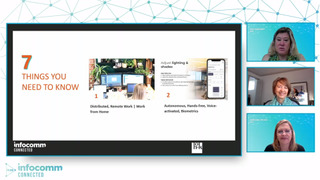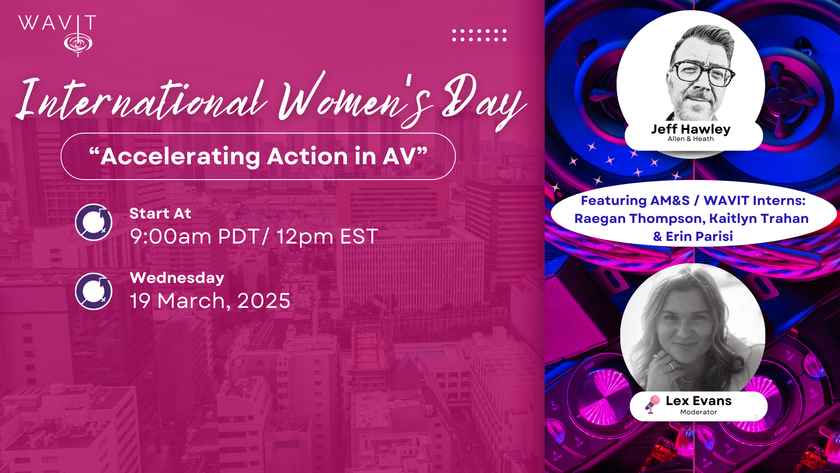Returning to the office will be different for every person, company, and location, but there are some general themes that emerged from InfoComm 2020 Connected on the topic of workplace reopening in a COVID-19 world.
AV technology will play an even more vital role in how people connect and collaborate. Look for increased adoption of an IoT-IT-AV ecosystem. Building sensors and AI will connect and process real-time information on occupancy and health safety guidelines, while digital signage systems will need to communicate updates on traffic patterns and sanitization efforts. And meeting rooms, well, they may look less like rooms and more like open collaboration areas.
For more insights on the role of AV integration in these evolving office technologies, check out the following sessions from InfoComm 2020 Connected.
Seven Things You Need to Know About the Future of Workplace Design
Working from home has been productive for some, but moving forward, it will be vital to have policies and procedures in place for optimal collaboration between remote and office-based teams. And assisting in the realization of those guidelines will be a whole bevy of “touchless” technologies.

“This is one of those areas where we believe the architectural world and the AV/IT world are going to come together finally .… We believe strongly that AV is not something that should come at the end, it’s something that should be baked into the beginning, and now that our clients are looking for hands-free voice activation and autonomous spaces, technology can play a major role in that. So, we really need to think about that going forward," said Kay Sargent, director of workplace at HOK.
As workplaces rethink things like airflow and HVAC design, sensors will provide feedback on any problem areas. AI will help to analyze the information, along with capacity and traffic patterns that might cause “pinch points” as people move through a space. This information will need to be communicated to those in the office, so they can change their paths accordingly.
“The Internet of Things will be moving to an Internet of Experience. Sensors and monitoring will keep us comfortable in that space, but also keep us safe," added Pam Light, regional leader for workplace in Los Angeles, HOK.
As chairs are pulled out of meeting rooms and setups evolve for hosting fewer people in a space, it’s also important to design for the specific use cases of a collaborative space. And regardless of a space’s purpose, it will be essential that remote and in-office participants have equal presence. When everyone was remote, everyone had the same basic setup in video chat platforms, and workers will expect that same equality in participation.
“What we don’t want to do is have the old traditional setup where you have this box at the end of the table and there’s a voice talking and it’s completely disconnected from the team …. How do we up our game with technology to make sure that we’re giving everybody the same engagement and everybody’s connected?” concluded Adriana Rojas, director of interiors, HOK.
Click here to watch this InfoComm 2020 Connected session OnDemand.
Workplace 5.0, Just When You Thought We Had it All Figured Out …
There will be many devices and applications for the “touchless” office, including thermal cameras, facial recognition, wireless USB, NFC (near-field communication), QR codes, personal devices and apps, voice, sensors, wearables/AR for meetings, and LIDAR (Light Detection and Ranging) for occupancy. This session covers them all and gets into how the AV technology industry will play a role in deploying these for clients. But here’s one thing to consider as we move to a more common work-from-home world: personnel development and mentoring.
“What we can’t lose sight of is our next generation. How are they going to learn? We learned from others teaching us on the job, if everyone is working remotely, how will the next generation be taught and mentored?” questioned Pete Coman, global workplace and education technology specialist, PTS Consulting.
Click here to watch this InfoComm 2020 Connected session OnDemand.
The Role of the AV Professional in Future UCC Landscapes
Remote support of technology has been an ongoing evolution long before COVID-19, and that’s been an asset during this time. But there are still hurdles in enabling the office to optimally support remote meetings. It’s time to really start collaborating across design teams to make things work best to support people in the workplace.
“If you are the expert in this area … you have to be as clear as possible and you really have to present your expertise as something that’s non-negotiable," said Nick Nienaber, head of audiovisual infrastructure and director of UCC, WeWork.
It’s also important to recognize that we’re learning new facts about the virus every day, so the workplace will likely continue to evolve as new understanding develops.
“Be careful not to make hard and fast rules now until we get better data," concluded Julian Phillips, SVP for global workplace solutions, AVI-SPL.
Click here to watch this InfoComm 2020 Connected session OnDemand.
To read more InfoComm Connected stories, visit avnetwork.com/tag/infocomm.
Visit www.infocommshow.org for more information to view sessions from the InfoComm 2020 Connected education program. All sessions are free to attend.












